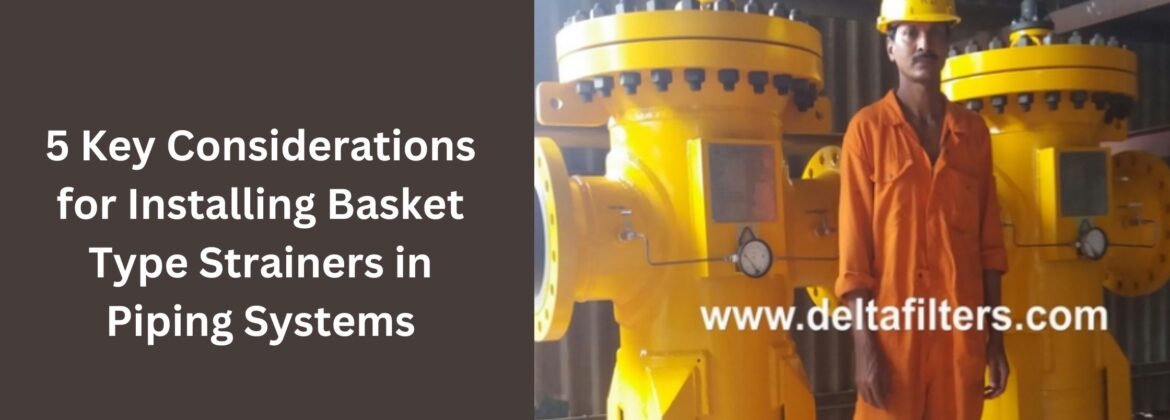
5 Key Considerations for Installing Basket-Type Strainers in Piping Systems
Basket-type strainers play a crucial role in maintaining the integrity and efficiency of piping systems by removing unwanted particulates and solids from flowing fluids. The proper installation of basket-type strainers is essential for ensuring optimal filtration performance and minimizing operational issues. In this blog, we will discuss the key considerations that should be taken into account when installing basket type strainers in piping systems. From selecting the appropriate strainer size and material to determining the optimal installation location and maintenance requirements, understanding these considerations will help maximize the effectiveness and longevity of your strainer system.
Identifying the Correct Strainer Size
One of the first considerations when installing a basket type strainer is selecting the appropriate size. The strainer size is determined based on the flow rate, pipe diameter, and the size and type of contaminants expected in the fluid. It is essential to match the strainer size to the system’s flow capacity to avoid pressure drop issues and maintain adequate filtration. Consulting with a strainer manufacturer or engineer can help determine the correct size based on the specific application requirements, ensuring optimum filtration performance without compromising the piping system’s overall functionality.
- Choosing the Proper Strainer Material
The choice of strainer material is crucial for withstanding the nature of the fluid being filtered and the prevailing operating conditions. Different materials such as stainless steel, bronze, or carbon steel offer varying levels of corrosion resistance, durability, and compatibility with different fluids. Factors such as temperature, pressure, and the presence of corrosive elements must be considered when selecting the appropriate strainer material. Using compatible materials helps avoid issues like premature wear, deterioration, and potential leakage, ensuring a longer service life for the strainer and maintaining the integrity of the piping system.
- Determining the Optimal Installation Location
Proper placement of basket type strainers is essential to maximize filtration efficiency and minimize pressure drop. The strainer should be installed where the fluid flow is the smoothest and where access for maintenance is convenient. Installing the strainer too close to pumps or valves can lead to turbulence and increased pressure drop, while placing it too far from the target area may hinder the strainer’s effectiveness. Ensuring sufficient straight pipe run before and after the strainer, in accordance with industry standards, facilitates proper fluid flow and enables easy maintenance, reducing the risk of clogging and facilitating strainer cleaning.
- Considering Pressure Ratings and Application Requirements
Basket type strainers are designed to withstand specific pressure ratings, and it is crucial to consider the pressure requirements of the application when installing them. The pressure rating of the strainer should match or exceed the maximum operating pressure of the system to prevent damage or failure. Additionally, special applications such as steam or high-temperature fluids may require strainers with specific features like reinforced baskets or thermal protection coatings. Understanding the specific needs and limitations of the application will help in selecting a strainer that can handle the required pressure levels and ensure optimal filtration performance and system reliability.
- Establishing an Effective Maintenance Routine
Regular maintenance is essential for the long-term performance and longevity of basket type strainers. Installing a strainer with easy access and appropriate isolation valves facilitates routine inspection, cleaning, and maintenance procedures. It is important to establish a maintenance schedule to ensure the strainer is cleaned or replaced as needed, minimizing the risk of clogging and maintaining optimal filtration efficiency. Furthermore, having spare parts readily available can help reduce downtime during maintenance activities. Developing a comprehensive maintenance routine tailored to the specific strainer and application will help ensure consistent filtration effectiveness and prolong the life of the entire piping system.
Conclusion:
Proper installation of basket type strainers is crucial for optimizing filtration performance and minimizing operational issues in piping systems. By carefully considering factors such as strainer size, material compatibility, installation location, pressure ratings, and maintenance requirements, businesses can ensure that their basket type strainers contribute to the efficient and reliable operation of their processes. A well-designed and maintained strainer system not only enhances filtration efficiency but also protects downstream equipment, reduces maintenance costs, and extends the life of the entire piping system. Investing time and effort into thoughtful installation considerations will yield substantial long-term benefits for businesses across various industries.
Any Queries: support@deltafilters.com
Copyright © 2021 All Rights Reserved.
